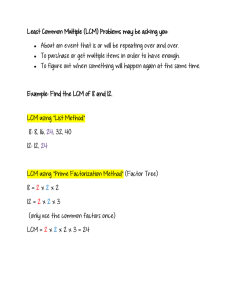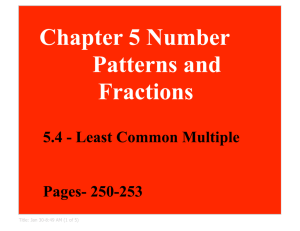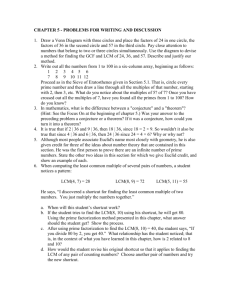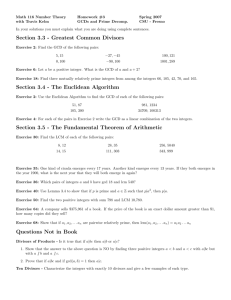MATH 8 ASSIGNMENT 1: LEAST COMMON MULTIPLE Reminder
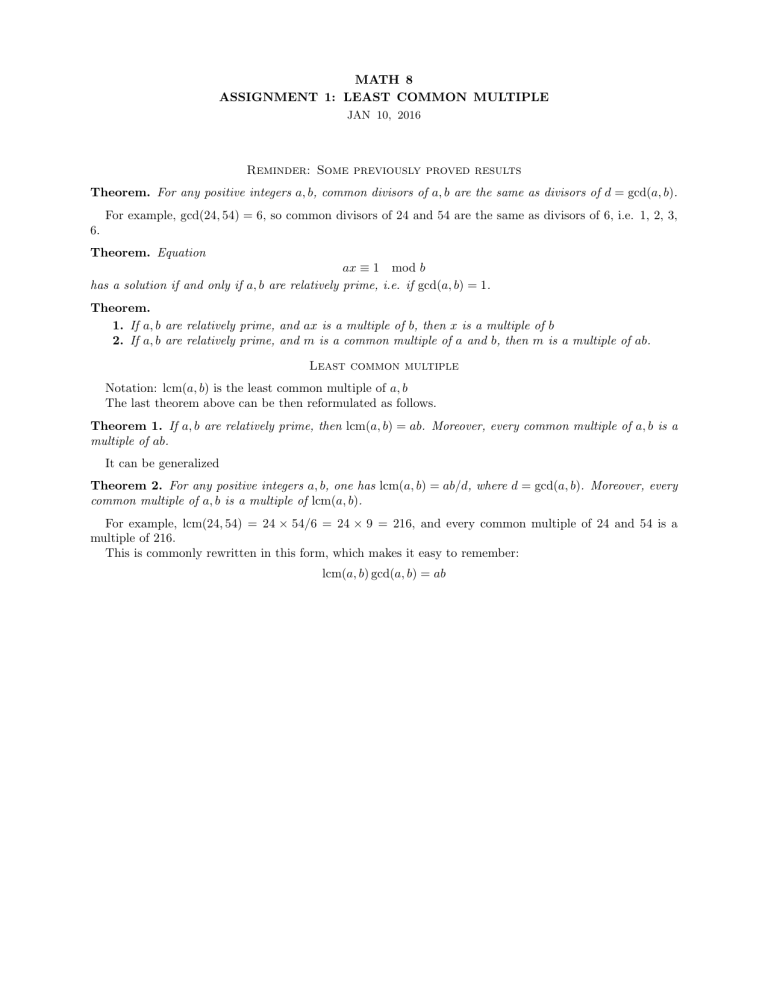
MATH 8
ASSIGNMENT 1: LEAST COMMON MULTIPLE
JAN 10, 2016
Reminder: Some previously proved results
Theorem.
For any positive integers a, b , common divisors of a, b are the same as divisors of d = gcd( a, b ) .
6.
For example, gcd(24 , 54) = 6, so common divisors of 24 and 54 are the same as divisors of 6, i.e. 1, 2, 3,
Theorem.
Equation ax ≡ 1 mod b has a solution if and only if a, b are relatively prime, i.e. if gcd( a, b ) = 1 .
Theorem.
1.
If a, b are relatively prime, and ax is a multiple of b , then x is a multiple of b
2.
If a, b are relatively prime, and m is a common multiple of a and b , then m is a multiple of ab .
Least common multiple
Notation: lcm( a, b ) is the least common multiple of a, b
The last theorem above can be then reformulated as follows.
Theorem 1.
If a, b are relatively prime, then lcm( a, b ) = ab . Moreover, every common multiple of a, b is a multiple of ab .
It can be generalized
Theorem 2.
For any positive integers a, b , one has lcm( a, b ) = ab/d , where d = gcd( a, b ) . Moreover, every common multiple of a, b is a multiple of lcm( a, b ) .
For example, lcm(24 , 54) = 24 × 54 / 6 = 24 × 9 = 216, and every common multiple of 24 and 54 is a multiple of 216.
This is commonly rewritten in this form, which makes it easy to remember: lcm( a, b ) gcd( a, b ) = ab
Problems
When doing this homework, be careful that you only use the material we had proved or discussed so far
— in particular, please do not use the prime factorization. And I ask that you only use integer numbers — no fractions or real numbers.
1.
Compute the least common multiple of the following pairs of numbers
(a) 18 and 40
(b) 512 and 250
(c) 1000 and 1001
2.
Among the numbers 1 - 1000, how many are common multiples of 70 and 42?
3.
Find the smallest number which is divisible by 12, 16, and 30.
4.
Two gears, an 18-tooth one and a 40-tooth one, are meshed. On the smaller gear, there is a (very small) paint stain; every time this point touches the other gear, it will leave a paint mark on it.
(a) How many paint marks will be left on the larger gear?
(b) How many revolutions will each gear make before paint stain on the smaller gear hits the point on the larger gear which already has a paint mark?
5.
(a) Prove that among the numbers 1, 11, 111, . . . one can choose two whose difference is divisible by 31.
(b) Prove that at least one of the numbers 1, 11, 111,. . . is divisible by 31.
6.
In this problem we deduce Theorem 2 from Theorem 1. We do it in steps.
(a) Let a, b be relatively prime. Without using Theorem 2, show that then, if n is a common multiple of 5 a, 5 b then n = 5 m , where m is a common multiple of a, b . Deduce that lcm(5 a, 5 b ) =
5 lcm( a, b ).
(b) Let a, b be relatively prime, and let d be any positive integer. Without using Theorem 2, show that then, every common multiple of da, db has the form dm , where m is a common multiple of a, b . Deduce that lcm( da, db ) = d lcm( a, b ).
(c) Prove Theorem 2.
*7.
Kathryn got a bag of coins. After counting them, she found that if you try to divide the coins into
5 equal piles, there will be two coins left; if you try to divide them into 4 piles, one coin will be left.
However, the coins can be divided into three equal piles. What is the smallest possible number of coins Kathryn could have?
8.
Last time we discussed check digits for ISBN. Here is another example of check digits: UPC (universal product code, printed on any product sold in US in the form of a bar code — the one scanned by the laser scanner at the checkout).
The usual UPC consists of 12 digits A
1
, . . . , A
12
, the last of which is the check digit, computed as follows:
A
12
≡ 3 A
1
+ A
2
+ 3 A
3
+ A
4
+ · · · + 3 A
11 mod 10
Thus, to check that a UPC is valid, it suffices to check the congruence above. If it fails, the UPC is invalid.
(a) Does this check detects all single digit errors? i.e., if when copying the UPC we make a mistake in one digit, will it always be detected by this check?
(b) Does this check always detect transpositions of two adjacent digits? (e.g., 37 ↔ 73)



